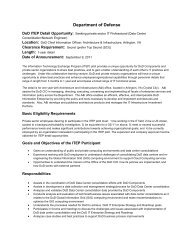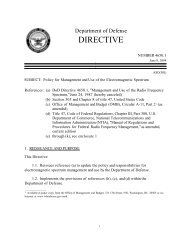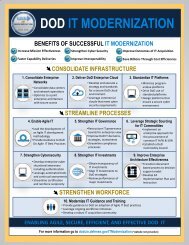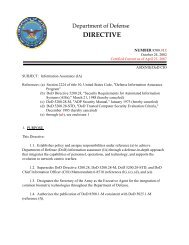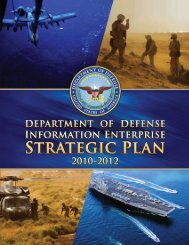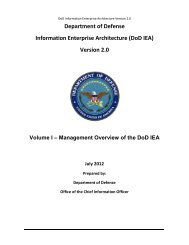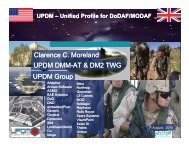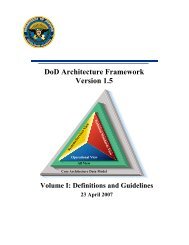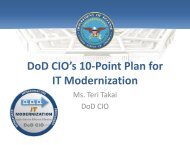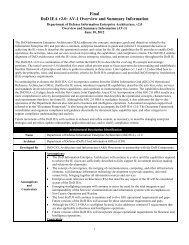DOD Info Sharing Strategy - Chief Information Officer
DOD Info Sharing Strategy - Chief Information Officer
DOD Info Sharing Strategy - Chief Information Officer
Create successful ePaper yourself
Turn your PDF publications into a flip-book with our unique Google optimized e-Paper software.
Department of Defense<strong>Info</strong>rmation <strong>Sharing</strong> <strong>Strategy</strong>O4 May 2007Prepared by:Department of Defense<strong>Info</strong>rmation <strong>Sharing</strong> ExecutiveOffice of the <strong>Chief</strong> <strong>Info</strong>rmation <strong>Officer</strong>
DoD <strong>Info</strong>rmation <strong>Sharing</strong> <strong>Strategy</strong>EXECUTIVE SUMMARYThis <strong>Info</strong>rmation <strong>Sharing</strong> <strong>Strategy</strong> provides a common vision to synchronize informationsharing initiatives and investments throughout the Department. <strong>Sharing</strong> of informationis an increasingly important element of Departmental mission success. It is imperative toeffectively exchange information among components, Federal agencies, coalitionpartners, foreign governments and international organizations as a critical element of ourefforts to defend the nation and execute national strategy. Through this <strong>Strategy</strong>, theDepartment will achieve improved unity of effort, a reduction in decision time, increasedadaptability of forces, improved situational awareness, and greater precision in missionplanning and execution.The Department of Defense (DoD) requires innovations to enhance information sharingacross the Department and with external partners. The evolving United States nationalsecurity environment necessitates an improvement to the Department‟s ability toeffectively and securely share information. Multiple national and departmental strategiesaffect information flow and accessibility, limiting the ability to leverage information as astrategic asset in achieving the Department‟s mission. Further, current events havediverse and global-reaching impacts, drawing the DoD into operations with diverse andunanticipated partners.The DoD <strong>Info</strong>rmation <strong>Sharing</strong> <strong>Strategy</strong> establishes thevision and goals for information sharing, while paving theway for a more detailed initiative to document theimplementing actions necessary to achieve these goals andrealize the vision.Improving the Department‟s ability to share informationhelps the DoD realize the power of information as aThe Department of Defense(DoD) <strong>Info</strong>rmation <strong>Sharing</strong><strong>Strategy</strong> provides thecommon vision, goals andapproaches that guide themany information sharinginitiatives and investmentsfor all DoD.strategic asset. Benefits include, but are not limited to: (1) Achieving unity of effortacross mission and coalition operations, (2) Improving the speed and execution ofdecisions, (3) Achieving rapid adaptability across mission and coalition operations, and(4) Improving the ability to anticipate events and resource needs, providing an initialsituational advantage and setting the conditions for success.<strong>Info</strong>rmation sharing is defined as, “Making information available to participants(people, processes, or systems).” <strong>Info</strong>rmation sharing includes the cultural, managerial,and technical behaviors by which one participant leverages information held or createdby another participant. This DoD <strong>Strategy</strong> establishes the vision for the future:Deliver the power of information to ensure mission successthrough an agile enterprise with freedom of maneuverability across the informationenvironment.ii
DoD <strong>Info</strong>rmation <strong>Sharing</strong> <strong>Strategy</strong>The vision describes a future state where transparent, open, agile, timely, and relevantinformation sharing occurs to promote freedom of maneuverability across a trustedinformation environment. To achieve the vision, this <strong>Strategy</strong> describes four goals thatform the necessary environment across the DoD. These goals are: (1) promote,encourage, and incentivize sharing; (2) achieve an extended enterprise; (3) strengthenagility in order to accommodate unanticipated partners and events; and (4) ensure trustacross organizations.The <strong>Info</strong>rmation <strong>Sharing</strong> <strong>Strategy</strong> guides the Department‟s sharing of information withinthe DoD and with Federal, state, local, tribal, coalition partners, foreign governments andsecurity forces, international organizations, non-governmental organizations, and theprivate sector, hereafter referred to as external partners. The <strong>Strategy</strong> represents the firststep in a comprehensive initiative to assess and modify as needed existing policies,business processes, budget allocations, and cultural perspectives.The focus on improving information sharing across the U.S. federal government isreflected in White House guidance, such as Executive Order 13388 “FurtherStrengthening the <strong>Sharing</strong> of Terrorism <strong>Info</strong>rmation to Protect Americans”, legislation,such as the Intelligence Reform and Terrorism Prevention Act (IRTPA) of 2004, andinternational cooperatives, such as the Multi-National <strong>Info</strong>rmation <strong>Sharing</strong> (MNIS)initiative. Numerous independent mission or functional area specific initiatives addressaspects of information sharing from intelligence and counter-terrorism, multinational, andstability operations, to humanitarian assistance and disaster relief. These strategies andefforts must be synchronized in order to achieve unity of effort as well as economic andoperational efficiencies.The DoD <strong>Info</strong>rmation <strong>Sharing</strong> <strong>Strategy</strong> establishes five touchstones of informationsharing: Culture, Policy, Governance, Economics and Resources, and Technology andInfrastructure. Each stakeholder community shall improve these five areas to realize theoverall goals of this <strong>Strategy</strong>.DoD shall develop an <strong>Info</strong>rmation <strong>Sharing</strong> Strategic Implementation Plan as a companiondocument. This Plan will provide integrated guidance to synchronize the manyinformation sharing activities, initiatives and investments supported by the DoD,including both internally and externally sponsored efforts. The Plan will expand the fiveimplementation considerations identified in this <strong>Strategy</strong> and provide descriptions of thespecific actions, roles, responsibilities, milestones and metrics.Every individual and organization in the Department of Defense plays an important rolein improving information sharing. Successful accomplishment of this <strong>Strategy</strong> will resultin efficiencies in operations, enhanced and shared situational awareness, and – ultimately– mission success. This strategy requires your involvement, assistance, and commitment.iii
DoD <strong>Info</strong>rmation <strong>Sharing</strong> <strong>Strategy</strong>iv
DoD <strong>Info</strong>rmation <strong>Sharing</strong> <strong>Strategy</strong>TABLE OF CONTENTSPurpose ................................................................................................................................ 2Vision .................................................................................................................................. 3<strong>Info</strong>rmation <strong>Sharing</strong> Landscape .......................................................................................... 3Goals ................................................................................................................................... 5Approaches to Achieve the Goals ....................................................................................... 6Implementation Considerations ........................................................................................ 10Culture........................................................................................................................... 10Policy ............................................................................................................................ 11Governance ................................................................................................................... 12Economics and Resources............................................................................................. 12Technology and Infrastructure ...................................................................................... 13Strategic Communications and Outreach.......................................................................... 14Appendix A. Glossary ....................................................................................................... 16Appendix B. Acronyms .................................................................................................... 18v
DoD <strong>Info</strong>rmation <strong>Sharing</strong> <strong>Strategy</strong>PurposeThe Department of Defense (DoD) <strong>Info</strong>rmation <strong>Sharing</strong> <strong>Strategy</strong> provides the commonvision, goals and approaches that guide the many information sharing initiatives andinvestments for the Department. This <strong>Strategy</strong> fulfills the imperative identified in theQuadrennial Defense Review (QDR). The <strong>Info</strong>rmation <strong>Sharing</strong> <strong>Strategy</strong> guides theDepartment‟s exchange of information within the DoD and with Federal, state, local,tribal, coalition partners, foreign governments and security forces, internationalorganizations, non-governmental organizations, and the private sector, hereafter referredto as external partners. This <strong>Strategy</strong> describes the information sharing approach for theOffice of the Secretary of Defense, the Chairman of the Joint <strong>Chief</strong>s of Staff, theCombatant Commands, the Military Departments, the Office of the Inspector General ofthe DoD, the Defense Agencies, the DoD Field Activities, and all other organizationalentities in the DoD. It guides the information sharing activities and operations amongthese DoD entities and with external partners. The <strong>Strategy</strong> establishes the Departmentalfoundation for strategic implementation planning.DoD shall develop an <strong>Info</strong>rmation <strong>Sharing</strong> StrategicImplementation Plan as a companion document. ThisPlan provides integrated guidance to synchronize themany information sharing activities, initiatives andinvestments supported by the DoD, including both“Develop an information-sharingstrategy to guide operations withFederal, state, local, and coalitionpartners.”- QDR February 2006internally and externally sponsored efforts. The Plan expands the five implementationconsiderations identified in this <strong>Strategy</strong> and provides descriptions of the specific actions,roles, responsibilities, milestones, metrics, and priorities.Effective information sharing enables the DoD to achieve dynamic situational awarenessand enhance decision making to promote unity of effort across the Department and withexternal partners. To accomplish these outcomes, this <strong>Strategy</strong> addresses the necessarychanges to information mobility and the associated alignment of incentives, policies,processes, and systems. Additionally, this <strong>Strategy</strong> identifies the critical cultural shiftrequired to support collaboration and improved knowledge sharing.The DoD intends to continue operating in the evolving federated approach forinformation sharing. Therefore this <strong>Strategy</strong> assumes that external partners‟ sharingcapabilities and philosophies will not necessarily conform to the DoD environment andculture, and that in the federated environment, autonomous enterprises will reach mutualagreement about participation in information sharing and the appropriate rules andstandards of conduct.2
DoD <strong>Info</strong>rmation <strong>Sharing</strong> <strong>Strategy</strong>VisionThe vision describes the desired future state for DoD <strong>Info</strong>rmation<strong>Sharing</strong>. It describes something that does not exist today, and itintentionally states “what” the future state includes, rather than“how” the Department arrives at such a state. The vision forinformation sharing for the DoD is:“Transforming to anetwork-centric forcerequires fundamentalchanges in process,policy, and culture.”National Defense<strong>Strategy</strong>, March 2005Deliver the power of information to ensure mission successthrough an agile enterprise with freedom of maneuverability across the informationenvironment.The vision above and the strategy articulated in this document enhance the Department‟sposition on information sharing by aligning the actions, initiatives, and behaviors of allinvolved. The vision describes a future state where transparent, open, agile, timely,relevant, and trusted information sharing occurs to promote freedom of maneuverabilityacross the information environment. Successful accomplishment of this vision will resultin efficiencies in operations, enhanced and shared situational awareness, and – ultimately– mission success.<strong>Info</strong>rmation <strong>Sharing</strong> LandscapeImproving information sharing constitutes a cornerstone of our national priorities. Themandates that enable and support this goal reside at the highest levels of authority - fromPublic Law to Presidential Executive Orders,National Strategies, and the DoD QDR. Theevolving United States national securityenvironment provides a context that is ripe foradvancing innovations to enhance the value ofinformation across the DoD and otheragencies. Within this context, the DoD ispursuing opportunities to exploit informationdominance against our adversaries andsupport effective, unified actions with ourexternal partners."The federal government is the largestpurchaser of information technology in theworld by far. One would think we couldshare information by now. But Katrinaagain proved we cannot."Executive Summary of Findings: Page 1,Congressional Reports: H. Rpt. 109-377 - AFailure of Initiative: Final Report of theSelect Bipartisan Committee to Investigatethe Preparation for and Response toHurricane KatrinaAs a result of the broad scope and multiple facets within the information environment,the definition of information sharing has taken on several variations. For purposes of this<strong>Strategy</strong>, information sharing is defined as, “Making information available toparticipants (people, processes, or systems).” <strong>Info</strong>rmation sharing includes thecultural, managerial, and technical behaviors by which one participant leveragesinformation held or created by another participant.The means by which information is shared in the information sharing landscape is vast,ranging from face-to-face interactions to real-time voice communications, to the latest3
DoD <strong>Info</strong>rmation <strong>Sharing</strong> <strong>Strategy</strong>messaging and data technologies that pass information across trusted networks. TheDepartment must have the ability to transfer information to and obtain information fromexternal partners overcoming situations where these partners may have disparateprocesses and capabilities and whose role and nature may not be known prior to an event.The DoD will share sensitive information currently protected by statute with authorizedusers, while maintaining an awareness of where and how this information is used.Current events have diverse and global-reaching impacts, drawing the DoD intooperational scenarios with varied partners. The DoD cannot always anticipate the eventsof tomorrow - solutions must transcend today‟s scenarios and provide the DoD the abilityto accommodate dynamically changing coalitions, external partners, and informationsharing requirements. The multiple, ongoing efforts in the pursuit of information sharingdemonstrate that classified/national security-related information is one of many nationalpriorities for information sharing.Numerous independent mission or functional area specific initiatives address aspects ofinformation sharing from intelligence and counter-terrorism, multinational, and stabilityoperations, to humanitarian assistance and disaster relief. These individual efforts, whileyielding benefits, are narrowly focused with no coordination or overarching guidance.This problem-specific approach continues to result in gaps, disparate solutions, andredundant efforts. This leaves significant issues associated with normalization ofstandards, cost inefficiency, risk management, trust mechanisms, and agreed upon rulesfor information categorization, classification and sharing.The DoD acknowledges the value of information sharing cannot be fully achieved withmultiple independent initiatives. The QDR directs the Department to: “Improve theDepartment‟s information sharing with otheragencies and with international allies andexternal partners by developing informationprotection policies and exploiting the latestcommercial technologies…to improveinformation sharing and informationassurance, and extend it across a multitude ofdomains, ranging from intelligence topersonnel systems.”"We must recognize that we are woefullyincapable of storing, moving, andaccessing information - especially in timesof crisis."Executive Summary of Findings: Page 1,Congressional Reports: H. Rpt. 109-377 - AFailure of Initiative: Final Report of theSelect Bipartisan Committee to Investigatethe Preparation for and Response toHurricane KatrinaThe DoD recognizes and shall leveragenational and departmental strategies and shall promulgate policy and guidance to promoteand embrace information flow and accessibility within the Department and with otherexternal partners. Comprehensive, effective response that maximizes freedom ofmaneuverability requires unity of effort, consistent guidance, and efficient ties into thebudget and resource allocation process. This <strong>Strategy</strong> leads the shift from situationalbasedinitiatives to a comprehensive unity of effort establishing supremacy in theinformation environment.4
DoD <strong>Info</strong>rmation <strong>Sharing</strong> <strong>Strategy</strong>GoalsThe goals describe the interrelated concepts needed to move the DoD from the currentstate of information sharing to the vision. The information sharing goals form anenvironment across the DoD that will:1. Promote, encourage, and incentivize sharing.Successful information sharing necessitates a mindset where information is continuallyshared as a normal course of work. It begins when organizational leaders set the exampleand demonstrate their commitment by advocating for information sharing, and will berealized when the dissemination of information is supported at all organizational levels.Leaders shall align individuals to the common information sharing vision and encouragethe adoption of the new mindset and culture. A common set of unifying approaches toDoD <strong>Info</strong>rmation <strong>Sharing</strong> will be developed, requirements validated, and individualstrained on the proper tools, techniques and procedures so that this common set ofinformation sharing practices is used at all levels throughout the Department.2. Achieve an extended enterprise.The extended enterprise refers to all internal andexternal participants required to ensure missionsuccess. This facilitates collaborative and coordinateddecision making, shared situational awareness andimproved knowledge at every level. The extendedenterprise requires the alignment of plans, processes,and systems across organizational and functionalboundaries.For Katrina, the extendedenterprise included DoD (activeand reserve), National Guard, DHS,FEMA, US Coast Guard, state andlocal governments, first responders,NGOs and SPCA.3. Strengthen agility, in order to accommodate unanticipated partners and events.Though it is important that the DoD continue to proactively plan for information sharingwith anticipated partners and events, it is also critical to prepare for unanticipatedpartners and events. To accomplish information sharing in diverse and disadvantagedsituations, the DoD shall enact and implement adaptive policies, guidance, practices,protections, and technologies.4. Ensure trust across organizations.A cornerstone of information sharing is trust - trust in the partner organizations including,but not limited to, their policies, procedures, systems, networks, and data. The DoD shalldevelop methods to promote and establish trust. These methods will take into accountand remain agile to accommodate differing levels of trust based on the environment,situation, and extended enterprise.5
DoD <strong>Info</strong>rmation <strong>Sharing</strong> <strong>Strategy</strong>Approaches to Achieve the GoalsThe information sharing goals will be accomplished through implementation of thefollowing approaches.1. Recognize and leverage the <strong>Info</strong>rmation <strong>Sharing</strong> Value Chain.The <strong>Info</strong>rmation <strong>Sharing</strong> Value Chain articulates the “opportunity” of informationsharing to support informed decision making, shared situational awareness and improveknowledge at every level of the DoD. The risks encountered at each step of theinformation sharing value chain must be managed to mitigate negative consequences.Throughout history, the supply of and demand for information triggers the inter-relatedprocesses of information collection, processing, analysis, and integration to makeinformed decisions, increase situational awareness, or improve and manage knowledge.Regardless of the mission domain, community or organization‟s unique processes formanaging information, the universal <strong>Info</strong>rmation <strong>Sharing</strong> Value Chain (as shown inFigure 1) remains the same – to discover and collect information and continuously addvalue at each stage to best inform a decision maker. In Figure 1, the information sharingactivities are described by the “Discovery to Decision” continuum. This continuumprovides the perspective of continual collaboration and enhancement of data to createrelevant and actionable knowledge.Figure 1: <strong>Info</strong>rmation <strong>Sharing</strong> Value Chain6
DoD <strong>Info</strong>rmation <strong>Sharing</strong> <strong>Strategy</strong>The strategic shift (opportunity) for theDepartment‟s information sharing is tocreate the governance, policy,technology, culture and economics thatpromote all aspects of the <strong>Info</strong>rmation<strong>Sharing</strong> Value Chain and facilitate theaccess, sharing and integration ofinformation such that the DoD hasfreedom of maneuverability.2. Forge information mobility."Many of the problems we have identified can becategorized as 'information gaps' - or at leastproblems with information-related implications orfailures to act decisively because information wassketchy at best.”Executive Summary of Findings: Page 1,Congressional Reports: H. Rpt. 109-377 - A Failureof Initiative: Final Report of the Select BipartisanCommittee to Investigate the Preparation for andResponse to Hurricane Katrina<strong>Info</strong>rmation mobility is the dynamic availability of information which is promoted by thebusiness rules, information systems, architectures, standards, and guidance/policy toaddress the needs of both planned and unanticipated information sharing partners andevents. <strong>Info</strong>rmation mobility provides the foundation for shared and user-definedsituational awareness. Trusted information must be made visible, accessible, andunderstandable to any authorized user in DoD or to external partners except wherelimited by law or policy.<strong>Info</strong>rmation mobility is both the foundation and core of the DoD <strong>Info</strong>rmation <strong>Sharing</strong>capability. There are five elements of information mobility, as described by thefollowing functional areas:Technology – enables the flow, management and processing of information. Technologyincludes architecture, core enterprise services, and information communications andtechnology infrastructure. Technology must support information mobility by requiringtrusted information to be visible, accessible, and understandable to any authorized user inDoD or to external partners except where limited by law or policy.Workforce <strong>Info</strong>rmation <strong>Sharing</strong> Competence – the workforce's ability to shareinformation across the enterprise. Workforce competence will be promoted throughleadership examples, shifts in cultural norms, and training on tactics, techniques andprocedures.Social Networks – the ability to form and join social networks and communities ofpractice. Trust relationships often begin with individual interactions that reinforce ashared mental model of the decision environment. Opportunities and norms to establishthese networks, build trust in, and accommodate the individual‟s operating practices willbe developed through the federated information sharing community approach.Policies – that enable information mobility across operational domains, clarifies roles andresponsibilities, defines relationships, harmonizes rules and procedures, and creates a riskmanaged environment that protects privacy and personal liberties. Spans entireinformation life cycle process from discovery to disposition.Security – that promotes information protection and sharing with assurance and trust ofinformation availability, integrity, authentication, confidentiality, and non-repudiation.7
DoD <strong>Info</strong>rmation <strong>Sharing</strong> <strong>Strategy</strong>3. Make information a force multiplier through sharing.<strong>Info</strong>rmation as a force multiplier refers to exploiting relative information advantagesagainst our adversaries and to support effective, unified disaster response. <strong>Sharing</strong> isinherent in information becoming a force multiplier and results in increased operationaleffectiveness.The following factors are challenges that must be addressed to enable information sharingto serve as a force multiplier:Volume - The amount of data that exists that could support the specific mission need orevent. As information sharing improves, the volume of data available to analyze fordecision making will continue to grow.Veracity - The ability to create relevance and de-conflict potentially conflicting datareceived from a number of sources. While analysts and decision-makers may receivemore information, more quickly, and from more directions, its accuracy, consistency,authority, currency and completeness must be validated.Velocity - The timeliness of information required as compared to the ability to obtain,transfer, and share information. Analysts and decision makers can receive a multitude ofinformation from a variety of sources, in real- or near-real-time.Vector - <strong>Info</strong>rmation sharing is increasingly multidirectional and crosses domains andboundaries (e.g., mission, functional, organizational, security, classification).4. Promote a federated <strong>Info</strong>rmation <strong>Sharing</strong> Community/Environment.Governance, policy and cultural considerations establish the required multi-lateralrelationships working in a regulated, risk management environment that ensuresinformation security, privacy, and trust. The federated approach establishes andmaintains a trusted community of information sharing that promotes collaboration,leverages the information integrators in the community and reduces the “seams” betweenorganizations, domains and functions.DoD operates with a federated approach toinformation sharing with external partners.This approach establishes the relationshipbetween legally autonomous entities andprovides a binding framework for informationsharing and collaboration. Federatedinformation sharing includes trustmechanisms, standards, procedures and auditregimes to establish and maintain trust andcompliance with the federation agreements.“Organizations that had worked together inthe past and had brought their informationsystems into alignment were able to respondmuch more quickly to the disaster.”“Lessons from KatrinaHealth,” a MarkleFoundation Report, 13 June 2006, detailing theeffort to coordinate and share individual healthrecords with physicians treating dispersedevacuees.8
DoD <strong>Info</strong>rmation <strong>Sharing</strong> <strong>Strategy</strong>5. Address the economic reality of information sharing.Create guidance and incentives within the budgeting and resource allocation process toencourage organizations to share information that promotes informed decision making,improves situational awareness, establishes economies of knowledge, and creates unity ofeffort.Orchestrating funding and resource investments is critical for the successfulimplementation of information sharing and achievement of unity of effort. Existinginitiatives, resources and evolving requirements must be integrated to efficiently usescarce resources. The requirements, acquisition and Planning, Programming, andBudgeting System (PPBS) processes must be synchronized to efficiently provide fundingand resources. A risk management approach will determine resource allocation andinvestment. Measures of effectiveness will determine return on investment and theeffectiveness of the DoD information sharing initiative.9
DoD <strong>Info</strong>rmation <strong>Sharing</strong> <strong>Strategy</strong>Implementation ConsiderationsThis <strong>Strategy</strong> requires the development and execution of the <strong>Info</strong>rmation <strong>Sharing</strong>Strategic Implementation Plan. Implementation planning and execution will bewidespread and occur at all levels. Success will be a unified and coordinated set ofinitiatives, spanning from Department leadership tosystem owners and operators, to the warfighter.The future cross-cutting <strong>Info</strong>rmation <strong>Sharing</strong>Implementation Plan will consider five keyThis <strong>Strategy</strong> provides the umbrellaunder which the implementation ofcurrent and future informationsharing initiatives will align.touchstones: culture, policy, governance, economics and resources, and technology andinfrastructure. (as shown in Figure 2).Figure 2: <strong>Info</strong>rmation <strong>Sharing</strong> Implementation TouchstonesCultureSuccessful information sharing requires a majorcultural shift across the DoD. There is anestablished mindset of information “ownership”.The new mindset must be one of information“stewardship”. The best technology, processes,and policies will not make this successful if thepeople do not embrace the new cultural norms.The Need for Organizational Flexibility.“…The protocols in place on 9/11 for theFAA and NORAD to respond to ahijacking presumed that…there would betime to address the problem through theappropriate FAA and NORAD chains ofcommand.”The 911 Commission Report, p.1810
DoD <strong>Info</strong>rmation <strong>Sharing</strong> <strong>Strategy</strong>To facilitate this shift, organizational leaders must support this cultural change, set theexample, educate their people, and offer incentives for, and enforcement of informationsharing and stewardship.The organizational approach and philosophy to adopt a sharing posture will be driventhrough shared missions and the ability/flexibility to „realign‟ and adapt to changingcircumstances. Specific implementation activities will include, but are not limited to:• Influence all training curriculums from basic training to senior serviceschools.• Train on tactics, techniques, and procedures (TTPs) that clearly outlineinformation sharing approach and implementation plans.• Require each information sharing program or initiative to address the culturalconsiderations in implementation planning.• Establish a trusted risk management environment (and mindset).• Foster an environment to share information.o Recognize leaders who promote an information sharingenvironment.o Offer incentives to embrace information sharing and stewardship.o Encourage participation in Communities of Interest.PolicyClear, concise and comprehensive guidance is necessary to implement this <strong>Info</strong>rmation<strong>Sharing</strong> <strong>Strategy</strong>. Laws, policies, regulations, and business rules must be evaluated andadjusted, as required, to facilitate the flow of information across the federatedinformation sharing community, including all external partners. Policies must beconsistent and harmonized at multiple levels, including national and international lawsand regulations that affect all federal departments and agencies; individual agencyguidance for information sharing between and within agencies; policies guiding Federal,state, local and tribal relationships; and regulations affecting sharing and protection ofinformation between government agencies and the private sector. Precise guidance willresult in common methods and approaches, and promote both security and unity of effort.Specific implementation activities will include, but are not limited to:• Assess existing policy and guidance to address gaps and differences.• Reconcile diverse rules forinformation sharing amongpartners.• Establish and promote afederated approach with allpartners.o Establishtrustworthiness –people, technology,data, and processes.• Develop and align policy toimprove information mobility.Flexible Policy Execution. The Department ofHealth and Human Services (DHHS) Officefor Civil Rights (which oversees HIPAA) issued aspecial bulletin clarifying that, considering theemergency circumstances, organizations that didnot comply with the usual business associaterequirements would not be penalized as long asthey showed “good faith efforts” to protect theprivacy of health information “and toappropriately execute the agreements required bythe Privacy Rule as soon as practicable.”“Lessons from KatrinaHealth,” a MarkleFoundation Report, 13 June 200611
DoD <strong>Info</strong>rmation <strong>Sharing</strong> <strong>Strategy</strong>o Establish consistent rules for sharing information.o Establish simple and consistent rules for identifying, handling, andprotecting controlled information.• Promote sharing while preserving individual privacy protections and/or civilliberties.• Influence planning and programming guidance.GovernanceA comprehensive, widely understood governance framework is critical for creating andsustaining a federated information sharing community of organizations and individualsaligned to the information sharing vision and agreed upon rule sets and processes. Thegovernance framework must articulate the accountability and authority; promotestandards and guidelines; ensure a consistent well-defined approach, processes andprocedures; adjudicate disconnects; establish legaland policy enforcement; and use performancemeasures to ensure progress towards achieving theinformation sharing goals.The DoD‟s information sharing governanceframework leverages existing structures andmechanisms, as well as employs new ones as needed.The Department uses a federated approach thatestablishes the relationship between legallyautonomous entities focused on a common result.This provides a binding framework for informationsharing and collaboration, acknowledgesinterdependencies, and fosters outreach,“In addition to avoiding centralizationwhere possible, KatrinaHealth wasstructured in such a way as to prohibitaccess to aggregate data. Authorizedphysicians and pharmacists had theability to dispatch a query for onepatient at a time only… and theirquery could not be successfullysubmitted unless they were authorizedand had obtained specific informationabout the patient.”“Lessons from KatrinaHealth,” aMarkle Foundation Report, 13 June2006communication and coordination. A federated information sharing communitysynchronizes the many initiatives and investments through visibility and alignment.Specific implementation activities will include, but are not limited to:• Assign responsibilities for the authority, oversight, coordination, andintegration of information sharing across the DoD and with external partners.• Implement processes to:o Promote standards and guidelines,o Ensure a consistent well-defined approach,o Adjudicate disconnects,o Establish legal and policy enforcement, ando Measure performance.• Align current information sharing initiatives and programs.Economics and ResourcesThe DoD shall tie information sharing to the Department‟s fiscal dimension. The QDRspecifically directs that the Department will “…reach investment decisions throughcollaboration among the joint warfighter, acquisition and resource communities…begin12
DoD <strong>Info</strong>rmation <strong>Sharing</strong> <strong>Strategy</strong>to break out its budget according to joint capability areas…manage the budget allocationprocess with accountability … (and) establish „Capital Accounts‟ for Major AcquisitionPrograms.”In order to comply with the QDR and tomaximize capabilities, the Department willstrategically prioritize planning andProgram Objective Memorandumsubmissions and purposefully guideProgram Evaluation Guidance deliberations.Through portfolio management, acoordinated, integrated enterprise will makeDoD <strong>Info</strong>rmation <strong>Sharing</strong> not only moretimely, but also more efficient and costeffective for the government. The up-front"DoD lacked an information sharingprotocol that would have enhanced jointsituational awareness and communicationsbetween all military components."Executive Summary of Findings: Page 4,Congressional Reports: H. Rpt. 109-377 - AFailure of Initiative: Final Report of theSelect Bipartisan Committee to Investigatethe Preparation for and Response toHurricane Katrinainvestment in the vertical and horizontal alignment of plans, processes, and systems forinformation sharing across organizational and functional boundaries will facilitatecollaboration and informed decision making, and will ultimately result in a significantreturn-on-investment for the DoD.To this end, the DoD will create guidance and incentives within the budgeting andresource allocation process to encourage organizations to share information that promotesinformed decision making, improves situational awareness, establishes economies ofknowledge, and reduces duplication of effort. This is always a priority, but will be evenmore critical as the Department enters an era of potentially diminishing resources.Specific implementation activities will include, but are not limited to:• Incorporate information sharing objectives into the requirements, acquisition,planning, and budgeting processes (e.g., JCIDS, PPBS, acquisition process).• Establish guidance and priorities within the budgeting and resource allocationprocess.• Leverage synergy of combined investments with external partnersTechnology and InfrastructureEnabling information sharing through the use and practice of current technology and theexploitation of potential future technology allows for improvements to the assured flow,management, and processing of information. The DoD will leverage the manyinvestments it has made, and will continue to make, within the net-centric and theinformation technology (IT) environment. The DoD will work with external partnerswho have highly developed technology support for information sharing whilemaintaining capabilities to work with external partners who have limited or notechnology support for information sharing.The DoD must keep in mind that technology alone will not solve the information sharinggap. While leveraging available technologies to the fullest extent, the DoD will continueto advance itself and its external partners in the areas of information delivery,13
DoD <strong>Info</strong>rmation <strong>Sharing</strong> <strong>Strategy</strong>collaboration, and information and knowledge management. The DoD will ensurecontinued investment, business process advancement, overarching technology standards,and the promotion of a broader information sharing culture among people andorganizations. These efforts will allow the DoD to realize the full benefits thattechnology will provide as an enabler within the DoD community and for our partners.Emerging technologies offer varying levels of increased capability for informationsharing. The emphasis for DoD will be on procuring technology that is standards-basedand conformant to DoD architectures. Technology procurements to support informationsharing must be guided by the tenets of interoperability, accessability, ease of use, andcompliance with security directives.Specific implementation activities will include, but are not limited to:• Comply with the DoD Enterprise Architecture and Federal EnterpriseArchitecture guidance.• Implement Federally compliant strong identity and access control.o Conform to the Federal Identity Management Federation standards.o Advocate technically equivalent solutions with other external partners.• Implement existing DoD and Federal technology strategies.• Apply technology to improve information mobility by requiring trustedinformation to be visible, accessible, and understandable to any authorizeduser in DoD or to external partners except where limited by law or policy.• Participate in developing, promoting, and enabling use of standards bypartners.Strategic Communications and OutreachTransforming the DoD to an organization with an information sharing mindset is achallenging effort. The DoD must address and change deeply rooted paradigms of “howthings have always been done.” Involving DoD stakeholders through communicationsand outreach is crucial to gaining the buy-in and participation that is needed tosuccessfully foster information sharing. Leaders, in particular, will play a key role indefining this change and in building support both across the Department and withexternal partners.The Department-wide communication and outreach initiative is an ongoing effort toensure that this <strong>Info</strong>rmation <strong>Sharing</strong> <strong>Strategy</strong> and future Implementation Plans areproperly promulgated, commonly understood and that all interested parties, programs,and initiatives can recognize their role in the information sharing vision. Communicationplanning involves the development of messages that are used to describe key aspects ofthe <strong>Info</strong>rmation <strong>Sharing</strong> <strong>Strategy</strong> and Implementation Plans. This communication efforthas begun and will continue to evolve. The initial messages that the DoD has developedfor communication include:• The <strong>Info</strong>rmation <strong>Sharing</strong> <strong>Strategy</strong> shifts information sharing from situationalbasedinitiatives to a comprehensive unity of effort..14
DoD <strong>Info</strong>rmation <strong>Sharing</strong> <strong>Strategy</strong>• The intent of the <strong>Info</strong>rmation <strong>Sharing</strong> <strong>Strategy</strong> is to have single, integratedguidance that synchronizes information sharing initiatives and investments toachieve the vision. This guidance and associated processes and tools will givethe DoD the flexibility to share information with planned and unanticipatedpartners across planned and unanticipated events.The messages are matched to theappropriate stakeholders to ensure thatgroups receive what is most important totheir interests. The intent is to buildlasting commitment that will propel DoD<strong>Info</strong>rmation <strong>Sharing</strong> toward theDepartment‟s vision.As part of the outreach activities, the DoDwill assist in the establishment of socialnetworks and Communities of Practice toinform, involve, and align stakeholders inStrategic Communications and Outreach.“In July 1995, Attorney General Janet Renoissued formal procedures aimed at managinginformation sharing between JusticeDepartment prosecutors and the FBI…Theseprocedures were almost immediatelymisunderstood and misapplied. As a result,there was far less information sharing andcoordination between the FBI and theCriminal Division in practice than wasallowed under the department’s procedures.”The 911 Commission Report,” p. 79the undertaking of information sharing initiatives. In addition, the Department will seekopportunities to reach out to partner organizations that may benefit from this informationsharing initiative. It is through these outreach activities that the DoD and its externalpartners will learn and implement best practices in information sharing. Thecommunications and outreach initiative must be a strategic, Department-wide effort toinform, involve, and mobilize the DoD and its partners toward the information sharingvision.15
DoD <strong>Info</strong>rmation <strong>Sharing</strong> <strong>Strategy</strong>Appendix A. GlossaryCollaboration – pattern of interaction where two or more parties are working togethertoward a common purpose.Data – Representation of facts, concepts or instructions in a formalized manner suitablefor communication, interpretation or processing by humans or automatic means. Anyrepresentation such as characters or analog quantities to which meaning is or night beassigned. (source: Joint Publication 1-02 of 12 April 2001 as amended through 09 Nov2006)Domains - A sphere of activity, concern, or function (source: The American Heritage®Dictionary).Enterprise Integration – The vertical and horizontal alignment of plans, businessprocesses, and information systems across organizational and functional boundaries toprovide competitive advantage.Federation –1. Autonomous organizations operating under a common rule set to a common purpose.2. Legally-binding framework to establish and maintain trust among autonomousorganizations.<strong>Info</strong>rmation –1. Any communication or representation of knowledge such as facts, data, or opinion inany medium or form, including textual, numerical, graphic, cartographic, narrative, oraudiovisual forms (source: DoD Directive 8000.1).2. Facts, data, or instructions in any medium or form.3. The meaning that a human assigns to data by means of the known conventions used intheir representation (source: DoD Dictionary http://www.dtic.mil/doctrine/jel/doddict/).<strong>Info</strong>rmation Mobility - The dynamic availability of information. <strong>Info</strong>rmation mobilityis aided or impeded by culture, policy, governance, economics and resources andtechnology and infrastructure.<strong>Info</strong>rmation <strong>Sharing</strong> - Making information available to participants (people, processes,or systems). <strong>Info</strong>rmation sharing includes the cultural, managerial, and technicalbehaviors by which one participant leverages information held or created by anotherparticipant.Networks – A complex, interconnected group or system (source: The American Heritage®Dictionary). These networks include social, information technology, and communicationnetworks.16
DoD <strong>Info</strong>rmation <strong>Sharing</strong> <strong>Strategy</strong>Partner – an entity that takes part in an information sharing activity with DoDRisk Management - The process of identifying, assessing, and controlling risks arisingfrom operational factors and making decisions that balance risk cost with missionbenefits (source: DoD Dictionary http://www.dtic.mil/doctrine/jel/doddict/).Stakeholder – a DoD entity with a direct interest, involvement, and investment in DoDinformation sharing.17
DoD <strong>Info</strong>rmation <strong>Sharing</strong> <strong>Strategy</strong>Appendix B. AcronymsDHS – Department of Homeland SecurityDoD – Department of DefenseFEMA – Federal Emergency Management AgencyJCIDS – Joint Capabilities Integration and Development SystemMNIS – Multi-National <strong>Info</strong>rmation <strong>Sharing</strong>NGO – Non-Governmental OrganizationPPBS – Planning, Programming, and Budgeting SystemQDR – Quadrennial Defense ReviewSPCA – Society for the Prevention of Cruelty to AnimalsTTP – Tactics, Techniques, and Procedures18




